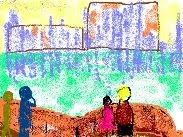 |
| 休日の午前中に ハイウェイを走ると 帰りのことは考えない |
*沖縄のCATIA職業訓練コースで自分が取っていた覚え書きから
*From my memo I was taking during my CATIA job training course in the Okinawa island, Japan
SECTION 1
「パブリッシュ」って何? What is a "Publication"?
Publishing elements is the process of creating geometrical features available to different
users. Useful when working in assembly design context. For example, constraints within the
component will be kept even after a component is replaced with another.
SECTION 2
パブリッシュの作成 Publishing Elements
1. パブリッシュの作成 Publishing Elements
Go to Tools > Publication (Available in both Part file and Assembly file)
Additional Note: How to select an axis for Publication
1) Right-click on he geometry
2) Select "Other selection" from the contextual menu
3) Select "Axis" in the pop-up winodw
2. パブリッシュ名の変更 Changing Published Names
1) Go to Tools > Publication
2) In the pop-up, select (highlight) the published name you want to modify, and then click on
it one more time.
3. Others
"Remove" button
"Import" button: Text files can be imported to CATIA. Useful when elemets to publish are
determined in the group or company. (Published names can be shared with other users in the same
group or company.)
"Export" button: Published names can be exported with text format.
"Publish a face, edge, axis, vertex, or extremity" check box:
SECTION 3
パブリッシュの活用方法 Utility of Publication
Useful when creating constraints, or working with contextual data
1. Publish faces, and create constraints with them.
Replace componets, and the constraints are not broken.
2. Working with contextual data
Go to Tools > Options > Part Infrastructure > General (tab) > External Reference (area)
==> Check "Keep link with selected object".
 |
Note: Published names will have to be assigned correspondingly
"Driving Part" consists of Sketches & surface, while "Contextual Part" Pad features.
|
SECTION 4
Other Notes on Publication
1. オプション設定 Option Settings
Go to Tools > Options > Part Infrastructure > General (tab) > External Reference (area)
"Only use published elements for external selection keeping link"
==> ON: Non-published elements cannot be selected.
"Publish a face, edge, axis, vertex or extremity"
==> ON: Can publish a face, edge, axis, vertex or extremity.
==> OFF: The elements above cannot be published.
2. パブリッシュ可能な要素 Elements below can be published
-Point, line, curve, plane
-Sketch
-Body (Note: Geo Sets cannot be published)
-PartDesign feature (CATIA settings)
-GSD feature (e.g. Volume surface)
-FSS feature
-Parameter
 |
| 土曜の朝は 猫が乗ってくる 二度寝もする |
付記: 自分が沖縄でCATIA講習を受けた際にとっていたノートを元に、おおまかな知識を書き出してみたのだけれども、久しぶりに見直してみて、随分いろんなことを習ったものだと改めて思うに到り、中には今になって、なるほどそういうことだったか、と合点のいくものもあったりで、復習をしてみる意味においても、当時のメモやノートを掘り起こすのは悪くないかと思い、書いてみた次第です。





















